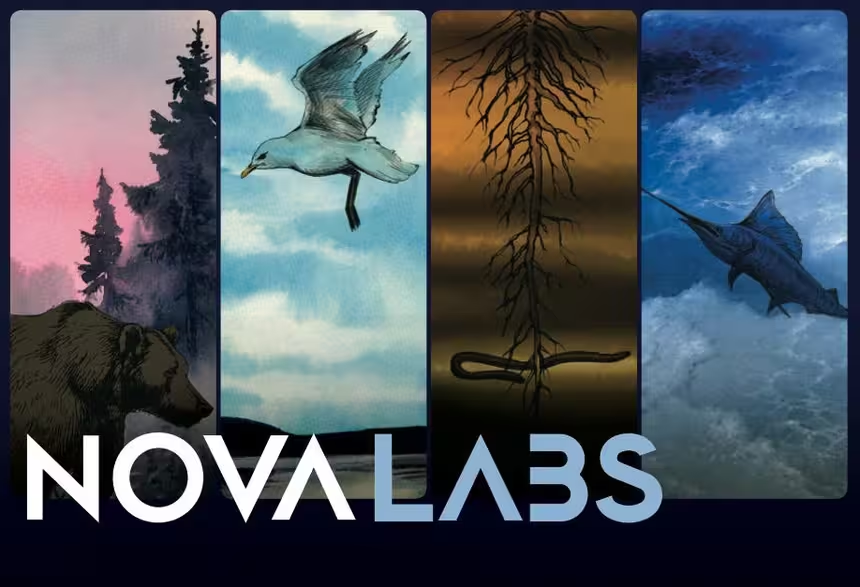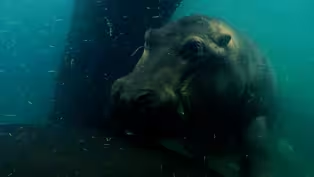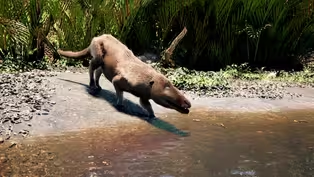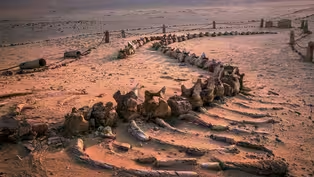
This Massive Skeleton Belongs to an Ancient Whale
Clip: Season 51 Episode 1 | 2m 28sVideo has Closed Captions
At first, scientists thought it was a gigantic marine reptile.
Egypt’s Sahara desert is home to around 600 Basilosaurus fossils. Basilosaurus means “king lizard,” but this creature was actually ancient whale.
Problems playing video? | Closed Captioning Feedback
Problems playing video? | Closed Captioning Feedback
National Corporate funding for NOVA is provided by Carlisle Companies and Viking Cruises. Major funding for NOVA is provided by the NOVA Science Trust, the Corporation for Public Broadcasting, and PBS viewers.

This Massive Skeleton Belongs to an Ancient Whale
Clip: Season 51 Episode 1 | 2m 28sVideo has Closed Captions
Egypt’s Sahara desert is home to around 600 Basilosaurus fossils. Basilosaurus means “king lizard,” but this creature was actually ancient whale.
Problems playing video? | Closed Captioning Feedback
How to Watch NOVA
NOVA is available to stream on pbs.org and the free PBS App, available on iPhone, Apple TV, Android TV, Android smartphones, Amazon Fire TV, Amazon Fire Tablet, Roku, Samsung Smart TV, and Vizio.
Buy Now

NOVA Labs
NOVA Labs is a free digital platform that engages teens and lifelong learners in games and interactives that foster authentic scientific exploration. Participants take part in real-world investigations by visualizing, analyzing, and playing with the same data that scientists use.Providing Support for PBS.org
Learn Moreabout PBS online sponsorship- This is one of the most complete skeletons that we find in Wadi al Hitan.
In the middle of nowhere, you find a lot of really huge vertebrae lying up.
The skull would be over there in that rock and the ribs on both sides.
This is really a spectacular, huge animal that lived here in Wadi al Hitan 40 million years ago, the Basilosaurus.
- Basilosaurus fossils have been discovered in many parts of the world, including around 600 here at Wadi al Hitan.
This one has been laid out in the place it was found.
When the first Basilosaurus was studied in 1834, experts were baffled.
- When the early scientists found this, they thought it's belonged to a kind of gigantic marine reptile, and this is why they give it name Basilosaurus, which means king lizard.
- But the skull contains a clue to Basilosaurus's true identity.
- This is the skull upside down, and you can see all the teeth is sticking up.
And actually, they have incisors, canine, premolars, and molar.
Really like our teeth, which is actually a really good indication for this is not a marine reptile.
This is actually mammal.
So, Basilosaurus, the King Lizard, it's actually ancient whale.
- 40 million years ago, Basilosaurus was the apex predator of its day.
It could grow up to 60 feet long, the length of a bowling alley, and weigh more than seven tons.
Powerful jaws filled with sharp teeth made it a killing machine.
Scientists estimate its bite had a force of nearly two tons, enough to crush the bones of other whales.
Basilosaurus was a prehistoric king of beasts.
Ancient whale fossils found in the desert
Video has Closed Captions
Clip: S51 Ep1 | 2m 10s | What is this whale skeleton doing in the Egyptian Sahara Desert? (2m 10s)
How Did Whales Evolve From Land Mammals?
Video has Closed Captions
Clip: S51 Ep1 | 3m 8s | The story of whales’ evolution from land mammals is hidden in their genes. (3m 8s)
Video has Closed Captions
Clip: S51 Ep1 | 2m 48s | Today’s whales look nothing like their ancient ancestor. (2m 48s)
When Whales Could Walk Preview
Video has Closed Captions
Preview: S51 Ep1 | 30s | Giant fossils uncovered in the Sahara Desert reveal new secrets of how whales evolved. (30s)
Providing Support for PBS.org
Learn Moreabout PBS online sponsorship
- Science and Nature

Capturing the splendor of the natural world, from the African plains to the Antarctic ice.













Support for PBS provided by:
National Corporate funding for NOVA is provided by Carlisle Companies and Viking Cruises. Major funding for NOVA is provided by the NOVA Science Trust, the Corporation for Public Broadcasting, and PBS viewers.






